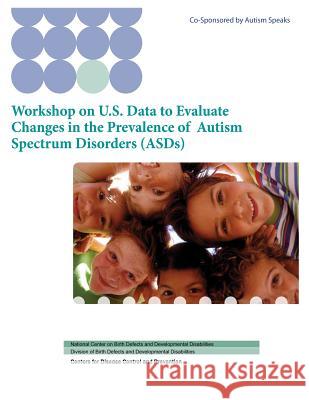Workshop on U.S. Data to Evaluate Changes in the Prevalence of Autism Spectrum Disorders (ASDs) » książka
Workshop on U.S. Data to Evaluate Changes in the Prevalence of Autism Spectrum Disorders (ASDs)
ISBN-13: 9781478281559 / Angielski / Miękka / 2012 / 52 str.
Autism spectrum disorders (ASDs) are estimated to occur among about 1% of children in the U.S. This is in line with estimates from other industrialized countries. However, the identified prevalence of ASDs has increased significantly in a short time period based on data from multiple studies including the Centers for Disease Control and Prevention's (CDC) Autism and Developmental Disabilities Monitoring (ADDM) Network. Whether increases in ASD prevalence are partly attributable to a true increase in the risk of developing ASD symptoms or solely to changes in com-munity awareness and identification patterns is not known. It is clear that more children are identified with an ASD now than in the past and the impact on individuals, families, and communities is significant. However, disentangling the many potential reasons for ASD prevalence increases has been challenging. Understanding the relative contribution of multiple factors such as variation in study methods, changes in diagnostic and community identification, and potential changes in risk factors is an important priority for the ADDM Network and for CDC. This workshop was co-sponsored by CDC and Autism Speaks as a forum for sharing knowledge and opinions of a diverse range of stakeholders about changes in ASD prevalence. This summary report reflects statements made by individuals at the forum and discussions that were held among the attendees, and does not constitute formal consensus recommendations to CDC. The information, research, and opinions shared during this workshop add to the knowledge base about ASD prevalence in an effort to stimulate further work to understand the multiple reasons behind increasing ASD prevalence in the U.S. The workshop brought together epidemiologic prevalence and surveillance experts in ASDs and other conditions as well as representatives from autism organizations, parents of children with ASDs, adults with an ASD, and other stakeholders. Panel members and attendees commented that the effort to increase transparency and expand the dialogue related to ASD prevalence change was appreciated and necessary to move the community forward around the issue of understanding ASD prevalence changes. Additional key points made during the workshop included: The identified prevalence of ASD has increased significantly in a short time period across multiple studies, including data from the CDC's U.S.-based Autism and Developmental Disabilities Monitoring (ADDM) Network; CDC is the source for ASD prevalence estimates in the U.S., but other data systems exist or could be developed to better understand trends in ASDs; ASDs are conditions estimated to occur among about 1% of children in the U.S. There is an urgent demand to address the many needs associated with ASDs; In terms of reasons for increased ASD prevalence, the debate has been dichotomized by researchers, advocacy groups, and the media to indicate that increases must be explained either by identification factors or by increased risk among the population. In reality, a more complex understanding is needed; Some people expressed hope that understanding why ASD prevalence has increased may help identify modifiable risk factors; There are likely multiple forms of ASDs with multiple causes that are poorly understood. It was noted that sufficient evidence exists that biologic and environmental factors, alone and in interaction, need to be considered as causes; A risk factor might be strongly associated with ASD and might be modifiable, but it might not have increased sufficiently in the population during the time frame of interest; There was a shared recognition of the importance of, and commitment to, obtaining and using prevalence and epidemiologic information to improve the lives of people with ASDs."
Zawartość książki może nie spełniać oczekiwań – reklamacje nie obejmują treści, która mogła nie być redakcyjnie ani merytorycznie opracowana.











